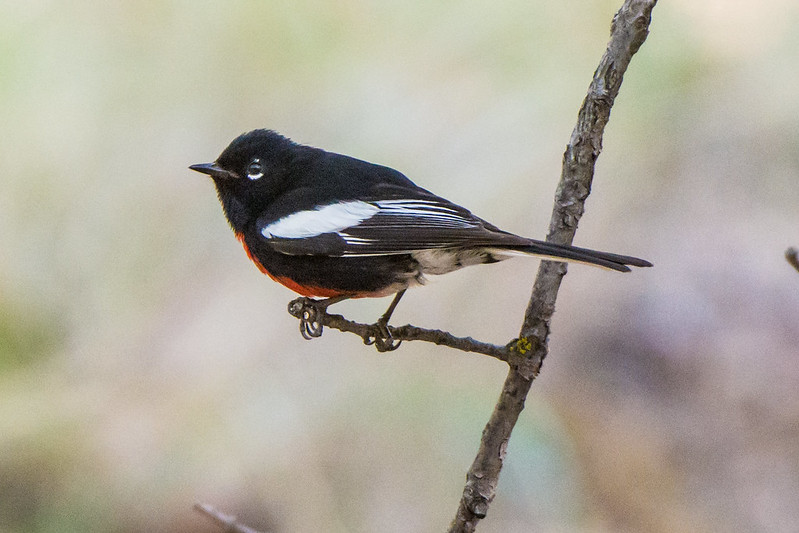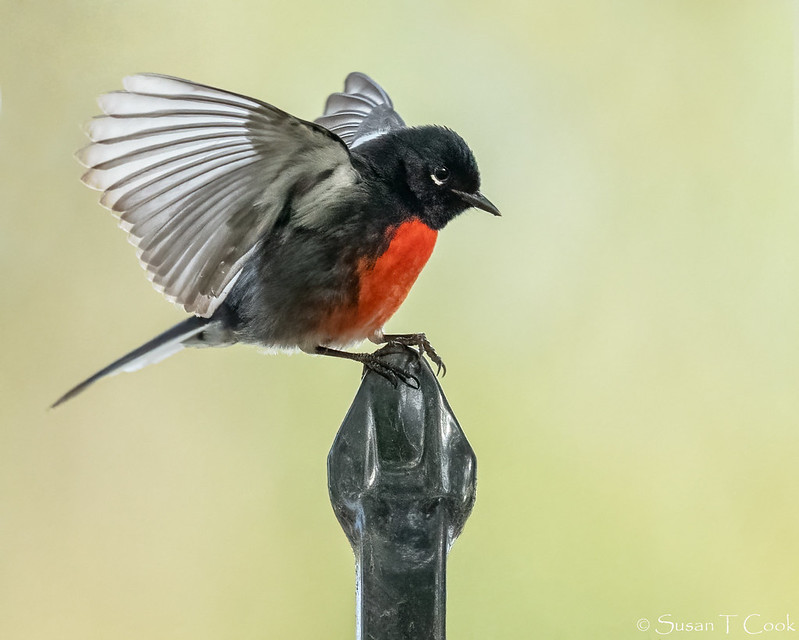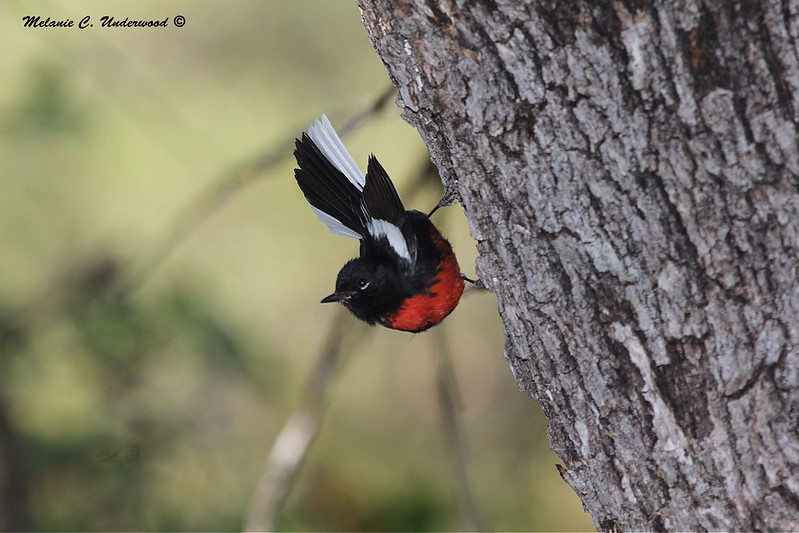The Painted Redstart is a species of warbler found in mountainous and canyon areas with oak and pine trees. Their plumage is striking; they’re mostly black with large white wing patches and a red belly. They often flash and fan their tails while foraging, revealing their bold tail feathers. They’re very active birds and can usually be seen darting around in the lower and mid-levels of trees. They’re primarily a Mexican species, and their breeding range narrowly extends into the southwestern U.S.
Identification
It’s hard to identify male and female when it comes to the Painted Redstart because they look very similar. However, males are slightly larger than females. Adult Painted Redstarts are velvety black for the most part. They have large white wing patches, white outer tail feathers, white crescents under the eyes, and a bright red belly. Juveniles are similar but are gray instead of scarlet on the belly. The males and females look alike in their plumage, which is rare for a warbler species.
Food
The Painted Redstarts diet consists mostly of insects. They forage by hopping along branches, opening their wings, and fanning their tails. This flashes the white on their feathers and startles insects into moving. When they forage in shady canyons, the white on their feathers is even more eye-catching against their almost fully black plumage.

Painted Redstarts pick insects from any part of the tree or off the surface of pools and streams. They have even been seen catching insects out of the air. In the spring, Painted Redstarts enhance their diet with sap from trees. Some insects they’ve been known to eat are butterflies, caterpillars, moths, flies, leafhoppers, and cicadas. They can sometimes be seen visiting backyard feeders like hummingbird feeders and in the winter suet feeders.
Nesting and Eggs
Painted Redstarts build their nests on slopes on the ground, rarely in trees. The nests are usually made in places that provide some sort of cover from above. This could be under bushes, on the side of a canyon, on a building, on a creek bed, or in cavities.
These nests have substantial-sized cups, usually made of pine needles, leaves, and grass. It’s lined with hair and fine grasses as well. Interestingly, many nests will have a pathway to them that is made of leaves. This pathway is usually on the downslope side. Nests are commonly four inches across and two pint six inches tall. The interior cup is around two inches across and one point three inches deep.
- Clutch size can range from three to seven eggs.
- Eggs are white with brown speckles. More brown speckles can be seen at the larger end of the egg.
Current Situation
It is estimated that the global breeding population of Painted Redstarts is six hundred thousand individuals. The species is rated thirteen out of twenty on the Continental Concern Score. This score means the species is of relatively low conservation concern. However, habitat loss is the main threat to the populations of this species. The forests they live in are often under duress from timber industries and development projects.

Facts
- When foraging, the Painted Redstart will flash the white patches on their outer tail feathers and wings. It’s been observed that this will flush insects out of hiding so that redstart cna pinpoint and pursue them.
- Painted Redstarts fan their tails when courting and later in the breeding cycle as a signal for young birds that are newly fledged. It’s not entirely understood why this is done. However, it’s theorized that it’s to keep them aware of their parents’ locations.
- Despite its name, the Painted Redstart is not closely related to the American Redstart. The term “redstart” comes from a number of European species of thrush that have bold reddish tail patterns.
- The oldest Painted Redstart on record was a male that lived to be at least six years and seven months old.
Similar Species
The Swainson’s Thrush has features that are similar to other bird species. Here are some similar species:
- Red-faced Warbler – Red-faced Warblers have red that is restricted to their face. Painted Redstarts have red that is limited to their bellies.
- American Redstart – American Redstarts have orange patches on their tail and wings, while painted redstarts have white patches on their tail and wings.
- Lark Bunting – Lark Buntings are larger than Painted Redstarts, have no lower white eye crescent, and have a larger bill.
FAQ
What is special about the Painted Redstart?
The Painted Redstart is special to the southwestern mountains of the United States. It’s also arguably the most beautiful warbler. They seem to intentionally show off their plumage as they dart through the trees, posing with its tail and wings slightly spread.
Where does a Painted Redstart live?
The Painted Redstart lives in the mountainous and canyon of Mexico and the southwestern U.S. They’re primarily a Mexican species, and their breeding range narrowly extends into the southwestern U.S.
What do Painted Redstarts eat?
Painted Redstarts diet consists mostly of insects. They forage by hopping along branches, opening their wings, and fanning their tails to show off their white plumage and scare insects.
How long do Painted Redstarts live?
The oldest Painted Redstart on record was a male that lived to be at least six years and seven months old.
Are Painted Redstart aggressive?
Painted Redstarts are relatively docile birds. They’re tolerant of other bird species in their territories but can become aggressive if other birds approach a nest.
Picture copyrights: Melanie C. Underwood (Flickr); Susan T. Cook (Flickr); Andrew Cannizzaro (Flickr)


